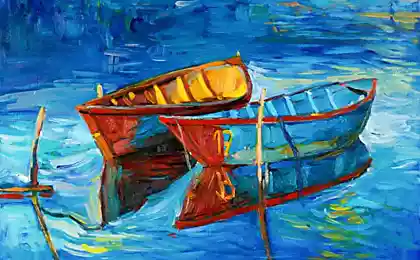552
"What's going on creativity?"
The legendary psychologist, author of the famous theory of "flow" Mihaly Csikszentmihalyi lecture "What's going on creativity?» Slon.ru published the main points of this chapter.
A set of human chromosomes are genetically very close to the genes of chimpanzees. But we are building a church, write music, launching missiles - we create. From the rest of the world makes us different creativity.
Before the advent of man on the planet has evolved much more slowly than it is now. Alas, creating new, we do not always think about the consequences. It is unlikely that the first German and American avtoinzhenery could imagine Moscow's traffic jams. The authors of the atomic bomb was a noble goal - to end the war with Nazi Germany, save millions of lives. And today, one press of the red button would destroy half of humanity. Artistic freedom can turn life into a nightmare - you need control, forcing the idea of working not for evil, but for the benefit.
Creativity scale and ochenUslovno creative process can be divided into two classes.
1. Creativity with a small letter "a". This individual creativity, which can afford to each of us. It manifests itself every day - how do you tie a tie or spread papers on the table. Even if you routinely perform the same actions in the given order, have a chance to become a creator. I talked with a man - he worked in a small diner forty years in a row, he sliced fish. But he described his work as it would make an artist or a poet. He came to the workplace at 4 am on the marble table were waiting for him five fishes. And each was unique for him. He imagined how it looks from the inside, is a kind of fish 3D, and selects a suitable knife. Then sliced fish as thinly and evenly as soon as possible. This man is proud of the work performed impeccably, seemingly far removed from the work. This principle also works in reverse: the most creative work - teaching, for example - can be turned into a routine, if you perceive students as a faceless mass. Not every teacher so refers to his disciples as the man to his big fish.
2. Creativity with a capital "C". This is an unusual, quite a rare phenomenon. Such creativity is not only changing the lives of the person from whom it comes, but the whole society. By itself, in isolation from society, this phenomenon does not exist. We ascribe to themselves the idea of the properties of "great creativity." Every day in someone's head, a new idea, but very few of them become valuable discoveries. From these few helpful thoughts only some can be made to work in a real life. Thus, most creative idea should have three main qualities: originality, value and the ability to apply it.
But who decides whether a new idea is a right to exist? For this there is a kind of field - the so-called gatekeepers. It is, in fact, all of us - those who embody the new theory. We open the door to innovation and a close them for others. The proof of the viability of the idea - its inclusion in the culture. Gatekeepers have in any field, for example, in a corporate society are managers who make decisions on changes in the company.
Why do people do? What drives people to this thankless task - creativity? At first you feel crazy, your idea is called senseless, and after it passed the test assigns all mankind. The only explanation - a theory of "flow." When a person creates something qualitatively new, it is completely absorbed in his work, he loses his sense of time and space, it is led by some force of nature. The Creator does not think about the past and the future, he has lived in some long present. In this creative man finds pleasure, it would seem, in a totally absurd things.
The poet enjoys well-chosen words, his task - to build the language units so that they have acquired a new subordinated to the general idea of the meaning. Astronomer observing the motion of galaxies through a telescope, apparently remained static, but the inside of his brain boils continuous operation. He can not move away from the device for several hours, and then, noticing the slightest change in the object being studied, to be the happiest of mortals. Scientist gets enormous pleasure from the continuous monitoring even microscopic cells - the subject of much less ambitious than the stars. Their main experience - they see something, whatever it was, first.
What is the chemical process of creating a new idea? The idea is born from the interaction of several parts of the brain or in our head has a special creative department? Having set himself this question, researchers conducted a study. Pianist placed in scanner, which has been the projector with the image of music, and computer keyboard, replacing the piano keys. The pianist was playing a fairly simple piece of music. Then he was asked to repeat the same play, but with a little improvisation. After the pianist was free, the scientists compared images of the brain during the first and second part of the experiment.
The findings confirmed the expectations: it turned out, there is a part of the brain that is activated only at the moment of improvisation, by repeating memorized it is disabled. This area of the brain responsible for the actions that we perform without a given model. It is very developed in poker players, chess players, by contrast, passive. Now students are taught to think in chess model. The moves their thoughts can be easily predicted.
Creative personality - what is it? Creative people are always surrounded by a thousand legends. It is believed, for example, that all introverts and singles. Most often it is not - a creative person should combine the two extremes. He needs to interact with the world in order to update the material for new discoveries. A box filled up with ideas, he should latch on to a couple of months, no one bothered to bring his ideas to life.
Typically, creative people, in moments when their head is not busy next project, a very lively and interesting. One 82-year-old scholar asked: "What would you like to change in yourself?" He replied: "I would like to be less lazy. I spend too much time on yourself, and could devote his science. " And this despite the fact that the scientist - the Nobel laureate and leader of the five laboratories. "I work every moment of my life - and I do not work ever. That's what I like to do, I do not consider it work. Science game for me ».
Another legend of the creatives - though most of them adherents of different sexual orientation. Of course, some of them are homosexuals, like in any other profession. Maybe they were a little more among artists than among accountants, and here's the thing. The creative person has the qualities inherent in both sexes. Women artists are usually determined and emotional, while men are shy. This feature creates cravings and to the representatives of their same sex.
Who are the judges? You were not paying attention to what is often a work of art, not tsenivshiesya one generation to the next are masterpieces? This phenomenon explained the familiar theory of "fields". The price of art is determined not by the creator and not a handful of connoisseurs, and all of society.
Michelangelo created three different versions of the "Pieta" - the sculpture depicting the Lamentation of the Virgin Mary lying on her lap Christ. The first was set up when he was about 20 years old, second - when Michelangelo was 64, and he finished third in the 80, shortly before his death. The work of the young master of his fame, she replied renaissance canons of beauty, was graceful and touching. The second expresses strength and power, finesse erstwhile left, and appreciated the sculpture is not so high. The third sculpture is close to the Art Nouveau style, it was not so familiar to the viewer's eye then, that it refused to stand for years to come just forgot about it. Remembered about it not so long ago - and she immediately gained thousands of fans.
Value creation - is relative. To the great art was not buried under tons of day works, you need to bring in the gatekeeper, that is around the cultural society, aesthetic taste, involved in the selection process as much as possible people. During the Renaissance in this game involved everything from kings to the street vagrants. Today, children are imprisoned in tight frames stereotypes: boys play with cars or war, the girls - dolls and daughters and mothers. This framework kill creative inclinations, so fragile at an early age. To return to the golden age of the Renaissance, it is necessary to change the system of education.
Valery Zhitkova
via www.slon.ru
A set of human chromosomes are genetically very close to the genes of chimpanzees. But we are building a church, write music, launching missiles - we create. From the rest of the world makes us different creativity.
Before the advent of man on the planet has evolved much more slowly than it is now. Alas, creating new, we do not always think about the consequences. It is unlikely that the first German and American avtoinzhenery could imagine Moscow's traffic jams. The authors of the atomic bomb was a noble goal - to end the war with Nazi Germany, save millions of lives. And today, one press of the red button would destroy half of humanity. Artistic freedom can turn life into a nightmare - you need control, forcing the idea of working not for evil, but for the benefit.
Creativity scale and ochenUslovno creative process can be divided into two classes.
1. Creativity with a small letter "a". This individual creativity, which can afford to each of us. It manifests itself every day - how do you tie a tie or spread papers on the table. Even if you routinely perform the same actions in the given order, have a chance to become a creator. I talked with a man - he worked in a small diner forty years in a row, he sliced fish. But he described his work as it would make an artist or a poet. He came to the workplace at 4 am on the marble table were waiting for him five fishes. And each was unique for him. He imagined how it looks from the inside, is a kind of fish 3D, and selects a suitable knife. Then sliced fish as thinly and evenly as soon as possible. This man is proud of the work performed impeccably, seemingly far removed from the work. This principle also works in reverse: the most creative work - teaching, for example - can be turned into a routine, if you perceive students as a faceless mass. Not every teacher so refers to his disciples as the man to his big fish.
2. Creativity with a capital "C". This is an unusual, quite a rare phenomenon. Such creativity is not only changing the lives of the person from whom it comes, but the whole society. By itself, in isolation from society, this phenomenon does not exist. We ascribe to themselves the idea of the properties of "great creativity." Every day in someone's head, a new idea, but very few of them become valuable discoveries. From these few helpful thoughts only some can be made to work in a real life. Thus, most creative idea should have three main qualities: originality, value and the ability to apply it.
But who decides whether a new idea is a right to exist? For this there is a kind of field - the so-called gatekeepers. It is, in fact, all of us - those who embody the new theory. We open the door to innovation and a close them for others. The proof of the viability of the idea - its inclusion in the culture. Gatekeepers have in any field, for example, in a corporate society are managers who make decisions on changes in the company.
Why do people do? What drives people to this thankless task - creativity? At first you feel crazy, your idea is called senseless, and after it passed the test assigns all mankind. The only explanation - a theory of "flow." When a person creates something qualitatively new, it is completely absorbed in his work, he loses his sense of time and space, it is led by some force of nature. The Creator does not think about the past and the future, he has lived in some long present. In this creative man finds pleasure, it would seem, in a totally absurd things.
The poet enjoys well-chosen words, his task - to build the language units so that they have acquired a new subordinated to the general idea of the meaning. Astronomer observing the motion of galaxies through a telescope, apparently remained static, but the inside of his brain boils continuous operation. He can not move away from the device for several hours, and then, noticing the slightest change in the object being studied, to be the happiest of mortals. Scientist gets enormous pleasure from the continuous monitoring even microscopic cells - the subject of much less ambitious than the stars. Their main experience - they see something, whatever it was, first.
What is the chemical process of creating a new idea? The idea is born from the interaction of several parts of the brain or in our head has a special creative department? Having set himself this question, researchers conducted a study. Pianist placed in scanner, which has been the projector with the image of music, and computer keyboard, replacing the piano keys. The pianist was playing a fairly simple piece of music. Then he was asked to repeat the same play, but with a little improvisation. After the pianist was free, the scientists compared images of the brain during the first and second part of the experiment.
The findings confirmed the expectations: it turned out, there is a part of the brain that is activated only at the moment of improvisation, by repeating memorized it is disabled. This area of the brain responsible for the actions that we perform without a given model. It is very developed in poker players, chess players, by contrast, passive. Now students are taught to think in chess model. The moves their thoughts can be easily predicted.
Creative personality - what is it? Creative people are always surrounded by a thousand legends. It is believed, for example, that all introverts and singles. Most often it is not - a creative person should combine the two extremes. He needs to interact with the world in order to update the material for new discoveries. A box filled up with ideas, he should latch on to a couple of months, no one bothered to bring his ideas to life.
Typically, creative people, in moments when their head is not busy next project, a very lively and interesting. One 82-year-old scholar asked: "What would you like to change in yourself?" He replied: "I would like to be less lazy. I spend too much time on yourself, and could devote his science. " And this despite the fact that the scientist - the Nobel laureate and leader of the five laboratories. "I work every moment of my life - and I do not work ever. That's what I like to do, I do not consider it work. Science game for me ».
Another legend of the creatives - though most of them adherents of different sexual orientation. Of course, some of them are homosexuals, like in any other profession. Maybe they were a little more among artists than among accountants, and here's the thing. The creative person has the qualities inherent in both sexes. Women artists are usually determined and emotional, while men are shy. This feature creates cravings and to the representatives of their same sex.
Who are the judges? You were not paying attention to what is often a work of art, not tsenivshiesya one generation to the next are masterpieces? This phenomenon explained the familiar theory of "fields". The price of art is determined not by the creator and not a handful of connoisseurs, and all of society.
Michelangelo created three different versions of the "Pieta" - the sculpture depicting the Lamentation of the Virgin Mary lying on her lap Christ. The first was set up when he was about 20 years old, second - when Michelangelo was 64, and he finished third in the 80, shortly before his death. The work of the young master of his fame, she replied renaissance canons of beauty, was graceful and touching. The second expresses strength and power, finesse erstwhile left, and appreciated the sculpture is not so high. The third sculpture is close to the Art Nouveau style, it was not so familiar to the viewer's eye then, that it refused to stand for years to come just forgot about it. Remembered about it not so long ago - and she immediately gained thousands of fans.
Value creation - is relative. To the great art was not buried under tons of day works, you need to bring in the gatekeeper, that is around the cultural society, aesthetic taste, involved in the selection process as much as possible people. During the Renaissance in this game involved everything from kings to the street vagrants. Today, children are imprisoned in tight frames stereotypes: boys play with cars or war, the girls - dolls and daughters and mothers. This framework kill creative inclinations, so fragile at an early age. To return to the golden age of the Renaissance, it is necessary to change the system of education.
Valery Zhitkova
via www.slon.ru























